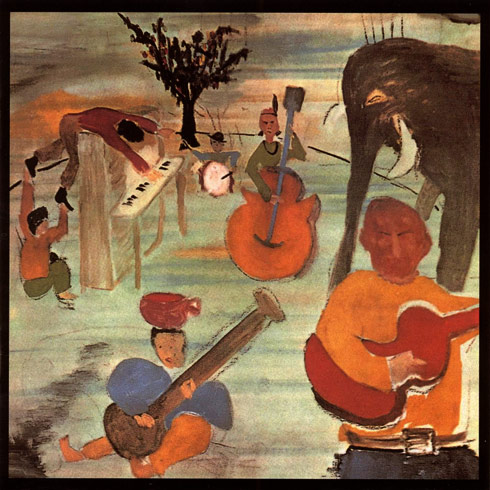
"Favella Villa Candido"
In his song “When I Paint My Masterpiece”, Bob Dylan yearns for the kind of artistic breakthrough that can literally remake the world around him:
Someday, everything is gonna be diff’rent/
When I paint my masterpiece
While a current show of the singer’s paintings hasn’t perceptibly changed the world as we know it, it has garnered a lot of positive attention and the handsome new catalog that accompanies the exhibit goes a long way toward explaining the appeal of this work to both the singer as his audience.
In addition to his legendary career in music, Bob Dylan has been a busy graphic artist since the ’60′s. For the uninitiated, Dylan’s visual work is probably most familiar as the cover art for his Self Portrait LP as well as for The Band’s Music from Big Pink record.

Taking a look at the new catalog Bob Dylan: The Brazil Series, it’s clear that the chameleon-like musician is just as mercurial in front of a canvas as he is in front of a mic. Documenting a current show at the National Gallery of Denmark (through January, 30), The Brazil Series boasts 40 brand new works that have never been shown publicly.
Most of Dylan’s paintings are created during his relentless touring schedule. Combined with his recent interest in acrylic paints, the artist’s newest paintings are surprisingly formal affairs, capturing his subjects in staged-seeming compositions. As in his songs, Dylan the painter has an eye for details and the banal minutiae that appear in his large canvases and drawings create a sense of realism within his frame, imbuing his portraits, landscapes and city scenes with soulful humanity and presence.
The National Gallery’s Director, Karsten Ohrt, compares Dylan’s work to that of Matisse while Danish critics have called the paintings “vulgar”. Of course, this is similar to what the critics of his time said about Matisse, so perhaps Dylan is on to something.
Most of the paintings in the book are reproduced as page size images, followed by blow-ups of details that spread across two-full pages, centerfold style. “Sideshow” presents the back of a hatted man watching a number of dancing girls on stage. On the following page a close-up of the women finds the central, masked dancer writhing front and center. “Barber Shop” is represented by an image of the full painting, a full-color detail as well as a small reproduction of the drawing that the painting is based on.

"Barber Shop"
National Gallery Chief Curator Kasper Monrad introduces Dylan as a painter with a short piece on the singer’s other career before summing up the book with a final word in his essay “The Brazil Series”. Here, Monrad illuminates the series by breaking the paintings down into separate subjects: Nightlife, Artists at work, People and religion etc. He also creates a greater art-historical context around Dylan’s paintings, evoking the work of a diverse group of predecessors including George Bellows, Caravaggio and – of course – Matisse. John Elderfield, Chief Curator Emeritus of Painting and Sculpture at the Museum of Modern Art, New York, also contributes an essay. “Across the Borderline” does a more than admirable job of creating unique connections between Dylan’s songs and canvases while also disentangling the two where one might be tempted to make easy assumptions about a woman in a painting and a woman in a song, for instance.
Read the rest of the review and find a link to a great Brazil Series gallery here.
Bob Dylan: The Brazil Series
Prestel Publishing
October 20, 2010
192 pages
Here’s a video of the late, great Elliot Smith covering Dylan’s “When I Paint My Masterpiece”







